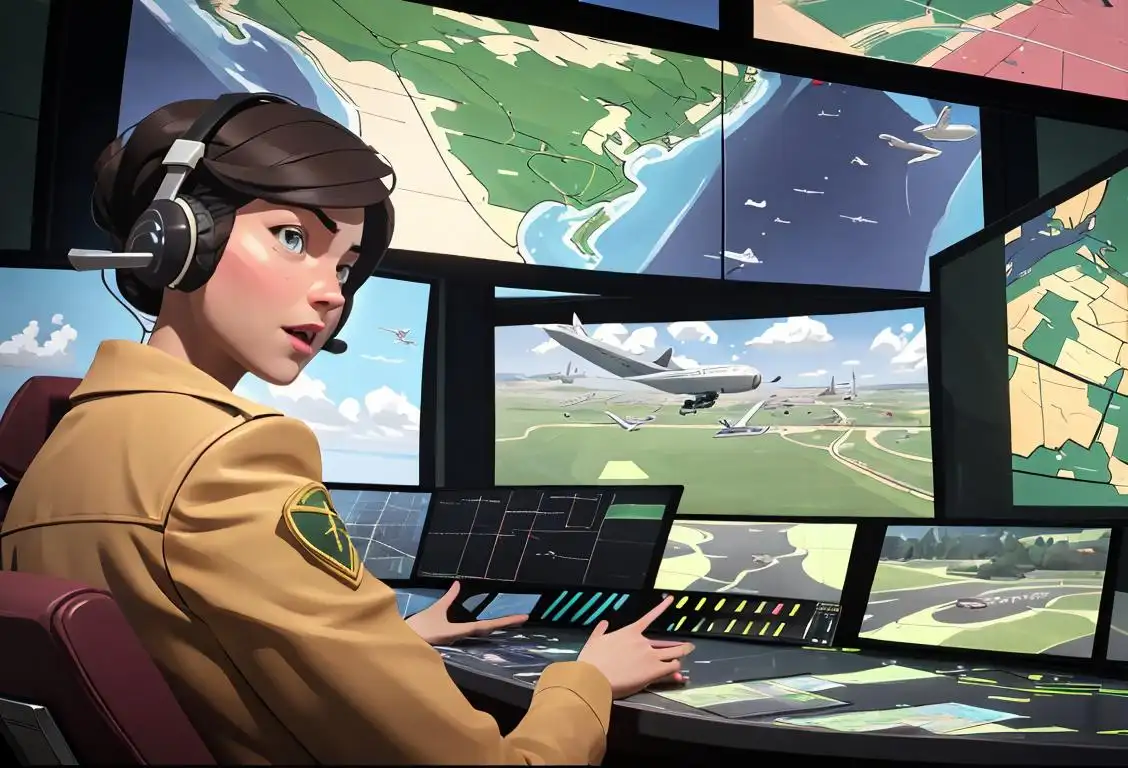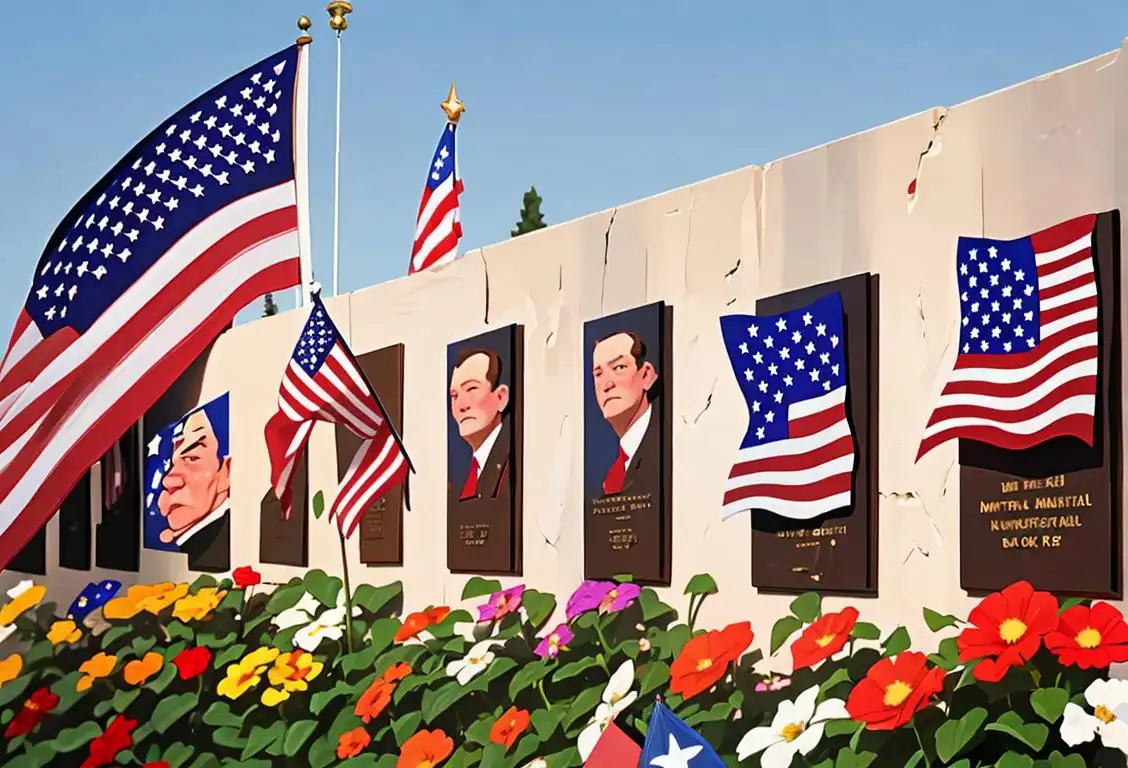National Air Traffic Controller Day

Ah, National Air Traffic Controller Day. A day when we celebrate the unsung heroes of the skies, the masterminds who ensure our flights stay on track and not on a collision course with a rogue seagull. It's a day to appreciate the men and women who keep our planes soaring gracefully through the air instead of awkwardly bumping into each other. So, grab your binoculars, put on your pilot hat (or just an aviator-themed t-shirt), and let's dive into the fascinating world of air traffic control!
When is Air Traffic Controller Day?
It's national air traffic controller day on the 6th July.
A Brief History of Air Traffic Control
Before we start geeking out over radar screens and radio jargon, let's take a quick trip back in time to the early days of aviation. Imagine a world without the organized chaos of air traffic control. Planes buzzing around like bees on caffeine, pilots playing a never-ending game of 'dodge the duck.' It was a free-for-all up there, my friend.
But fear not, for on November 25th, 1981, National Air Traffic Controller Day was officially recognized by the United States Congress. This special day commemorates the tireless efforts of air traffic controllers in keeping our skies safe and our flights smooth.
The Ground Control Magicians
Air traffic controllers are like the wizards of the aviation world. They calmly sit in their towers or control centers, orchestrating the aerial dance of planes with their magic wands... I mean, radios and computer screens. Using their encyclopedic knowledge of flight patterns, weather conditions, and plain old common sense, they guide planes through takeoff, landing, and everything in between.
Picture this: a pilot flying blind, the runway obscured by thick fog. But fear not! Our air traffic controllers come to the rescue, navigating the pilot safely onto the runway with their soothing voices crackling through the radio. It's like a beautiful ballet in the sky.
An International Celebration
National Air Traffic Controller Day is not just limited to the United States. Countries around the world join in this grand celebration of the men and women who keep the friendly skies, well, friendly. So, no matter where you are, take a moment to appreciate those invisible heroes guiding and directing our flights from behind the scenes.
History behind the term 'Air Traffic Controller'
1910
Birth of Aviation
The term 'air traffic controller' originated in 1910 with the birth of aviation. As airplanes began to take flight, it became necessary to establish a system for managing the increasing number of aircraft in the sky. The need for someone to guide and direct the movement of planes led to the development of the field of air traffic control.
1930
Beginnings of air traffic control
In the early days of aviation, as air travel began to become more widespread, there was a growing need for a system to manage the increasing number of flights. The term 'air traffic control' was first used in the 1930s to describe the process of coordinating and directing the movement of aircraft in order to ensure safety and efficiency in the skies.
1929
The Birth of Air Traffic Control
In 1929, the first air traffic control tower was established at Cleveland Municipal Airport in Ohio, United States. This marked the birth of air traffic control as we know it today. The tower facilitated communication between pilots and ground personnel, ensuring the safe and orderly movement of aircraft.
1917
Birth of military aviation control
The term 'air traffic controller' originated in 1917 with the birth of military aviation control during World War I. As aircraft became increasingly important in warfare, the need to coordinate and control their movements arose. Ground-based operators were assigned the task of directing military aircraft to ensure safe takeoffs, landings, and flight paths. This early form of air traffic control focused primarily on military operations.
1920
The Birth of Air Traffic Control
In the year 1920, the term 'air traffic controller' was born as a result of an emerging need for organized management of the growing number of aircraft. This term referred to individuals responsible for maintaining order and safety in the skies by directing and regulating the movement of airplanes.
1930s
The birth of air traffic control.
In the 1930s, as aviation began to advance rapidly, the need for regulating and directing air traffic became apparent. However, the term 'air traffic controller' had not yet come into existence. Instead, air traffic control was primarily carried out by pilots and ground personnel communicating over the radio to manage the flow of planes.
1941
The first use of the term 'air traffic control' in official documents.
It wasn't until 1941 that the term 'air traffic control' was officially used in a document issued by the U.S. Civil Aeronautics Administration. This marked the recognition and formalization of the role and responsibilities involved in managing the increasingly complex air traffic system.
1930
Introduction of Radio Communication
By the 1930s, significant advancements in communication technology, specifically the widespread adoption of radio, revolutionized the field of air traffic control. Air traffic controllers now had the ability to communicate directly with pilots, providing instructions and guidance in real-time.
1921
First Official Air Traffic Controller
In 1921, the first official air traffic controller was appointed in the United States. This marked the beginning of a more structured approach to managing air traffic. The controller's role was to monitor and regulate the movement of aircraft, ensuring safe takeoffs, landings, and flight paths. This development was crucial in improving aviation safety and preventing accidents.
1936
Introduction of the Term 'Air Traffic Controller'
The term 'air traffic controller' was first used in 1936, coined by the International Civil Aviation Organization (ICAO). This organization was formed to standardize and regulate civil aviation procedures internationally. The role of the air traffic controller became recognized as crucial in managing the increasing complexity of air traffic.
1920
Creation of the first civilian air traffic control system
In 1920, the first civilian air traffic control system was established in the United States. The U.S. Post Office Department, responsible for airmail transportation at the time, initiated the system to manage the increasing number of airmail flights. Airway traffic control sections were created to monitor and control airmail operations, ensuring efficient and safe delivery of mail. This marked the beginning of civilian air traffic control and the expansion of the term 'air traffic controller' beyond military use.
1941
Civil Aeronautics Authority establishes air traffic control system
In 1941, the Civil Aeronautics Authority (CAA) in the United States established the first official air traffic control system. This system aimed to regulate and monitor the movement of aircraft, ensuring the safe and orderly flow of air traffic. It marked a significant milestone in the development of air traffic control as a profession, and the term 'air traffic controller' became increasingly recognized.
1940
World War II and Radar
During World War II, radar technology played an instrumental role in air traffic control. Radar allowed controllers to track aircraft even in poor visibility conditions, enhancing safety and enabling more efficient management of airspace.
1930
Formation of centralized air traffic control organizations
By the 1930s, the aviation industry had experienced significant growth, necessitating the establishment of centralized air traffic control organizations. In 1936, the first national air traffic control organization, the Air Traffic Control division, was formed within the Civil Aeronautics Authority (CAA) in the United States. This step helped standardize air traffic control procedures and enhanced the role and importance of air traffic controllers in managing the increasingly complex airspace.
1950
Radar Revolutionizes Air Traffic Control
In the 1950s, radar technology revolutionized air traffic control. Radar allowed controllers to monitor the position and movement of aircraft in real-time, greatly enhancing their ability to provide safe and efficient separation between flights. This advancement in technology significantly improved the precision and effectiveness of air traffic control operations.
1956
Creation of the Federal Aviation Agency
In 1956, the Federal Aviation Agency (FAA) was established in the United States to oversee the regulation of civil aviation, including air traffic control. This consolidation of responsibilities helped to further professionalize the field of air traffic control and increase the importance of the role of air traffic controllers in ensuring the safety of the national airspace.
1930
Radio Communication Advancements
By 1930, advancements in radio communication technology greatly enhanced the effectiveness of air traffic control. Controllers could now communicate directly with pilots, providing instructions and guidance in real-time. This innovation revolutionized the field, allowing for more precise and efficient coordination of aircraft movements.
1949
The birth of the term 'air traffic controller'.
In 1949, the term 'air traffic controller' was introduced to describe and distinguish the individuals responsible for directing and coordinating the movement of aircraft. This term aptly captured the essential role of these professionals in ensuring the safety and efficiency of air travel.
1956
Creation of the first air traffic control tower.
In 1956, the world's first official air traffic control tower was constructed at Chicago Midway Airport in the United States. These towers provided air traffic controllers with a dedicated workspace equipped with communication tools, radar displays, and other essential equipment to effectively manage air traffic.
1970
Federal Aviation Administration (FAA) Becomes the U.S. Air Traffic Controller Authority
In 1970, the Federal Aviation Administration (FAA) became the official governing body responsible for air traffic control in the United States. The FAA took over from the Civil Aeronautics Administration, implementing additional regulations and modernization efforts to meet the growing demands of air travel.
1961
First radar-based air traffic control system
In 1961, the United States introduced the first radar-based air traffic control system, known as the National Airspace System (NAS). This advanced technology allowed controllers to track aircraft more accurately and efficiently, enhancing the safety and effectiveness of the air traffic control process. The term 'air traffic controller' became synonymous with the highly skilled professionals responsible for managing air traffic using this new system.
1949
Introduction of radar for air traffic control
The introduction of radar technology revolutionized air traffic control in 1949. Radar provided controllers with a real-time visualization of aircraft positions, greatly improving their ability to monitor and manage air traffic. This development allowed for enhanced safety, increased efficiency, and more precise control over airspace. The term 'air traffic controller' became even more closely associated with radar-based surveillance and communication systems.
1941
Federal Aviation Administration (FAA) Formation
In 1941, the Federal Aviation Administration (FAA) was established in the United States. The FAA took on the responsibility of regulating and overseeing air traffic control operations throughout the country. This centralization of authority further standardized air traffic control procedures and ensured consistent safety standards across the nation.
1950
Formalization of Air Traffic Control
In the 1950s, the term 'air traffic controller' became more formally established as a profession. Air traffic control systems began to be implemented on a larger scale, and training programs were developed to ensure controllers had the necessary skills and expertise to handle the increasing complexity of air traffic.
1956
Introduction of Radar
In 1956, radar technology was introduced into air traffic control systems. This development allowed controllers to track the position and movement of aircraft more accurately. Radar greatly improved situational awareness and enabled air traffic controllers to manage airspace more efficiently, minimizing the risk of collisions and improving overall operational safety.
1981
Professional Air Traffic Controllers Organization (PATCO) Strike
The year 1981 witnessed a significant event in the history of air traffic controllers. The Professional Air Traffic Controllers Organization (PATCO) staged a strike, demanding better pay, working conditions, and a reduced workweek. As a response, President Ronald Reagan ordered the firing of more than 11,000 controllers who refused to return to work, resulting in the dismissal of nearly the entire workforce.
1961
Federal Aviation Administration (FAA)
In 1961, the Federal Aviation Administration (FAA) was established in the United States, which further solidified the role of air traffic controllers. The FAA became responsible for setting regulations, standards, and oversight for air traffic control both domestically and internationally.
1978
Creation of the Federal Aviation Administration
In 1978, the Federal Aviation Administration (FAA) was established in the United States as an independent regulatory agency responsible for civil aviation safety and oversight. The FAA took over the air traffic control functions previously managed by the CAA, strengthening the professionalization of air traffic control. The term 'air traffic controller' gained further recognition and significance as the FAA continued to improve technology, training, and safety standards in the field.
1978
Creation of the Air Traffic Control System Command Center
In 1978, the Air Traffic Control System Command Center (ATCSCC) was established in the United States. This centralized facility was responsible for monitoring the entire national airspace system and coordinating responses to any exceptional circumstances or disruptions. The creation of the ATCSCC further emphasized the critical role played by air traffic controllers in maintaining the smooth operation of air transportation.
1968
The tragic crash that sparked improvements in air traffic control.
On June 30, 1968, a collision between two aircraft, one departing and one landing, occurred over New York City. The accident, which resulted in the loss of 134 lives, highlighted the need for significant improvements in air traffic control. This tragedy led to the implementation of new technologies, procedures, and training to enhance the safety and efficiency of air traffic management.
Present
Continuous Advancements in Technology and Training
In the present day, air traffic control continues to evolve with ongoing advancements in technology and training. Communication systems have become more sophisticated, including the integration of satellite-based navigation and digital data processing. Additionally, air traffic controllers undergo rigorous training programs to ensure they possess the necessary skills and knowledge to maintain the safety and efficiency of aviation operations.
1978
Global Harmonization
In 1978, the International Civil Aviation Organization (ICAO) established global standards and practices for air traffic control. This harmonization of procedures and protocols ensured consistency and compatibility among different countries' air traffic control systems. It facilitated international air travel and promoted safer and more efficient global aviation operations.
Present
Ongoing advancements in air traffic control
In the present day, air traffic control continues to evolve and incorporate new technologies and procedures. From the implementation of advanced automation systems to the integration of satellite-based navigation, the profession of air traffic controller is continuously adapting to meet the demands of modern aviation. The term 'air traffic controller' remains essential in describing the dedicated individuals responsible for ensuring the safety and efficiency of air travel worldwide.
Present
Evolution and modernization of air traffic control
Since its inception, air traffic control has continuously evolved and embraced technological advancements. The introduction of computer systems, satellite-based navigation, and digital communication has transformed air traffic control procedures. Today, air traffic controllers utilize sophisticated automation tools and collaborate with advanced systems to ensure the safe and efficient flow of air traffic. The term 'air traffic controller' remains synonymous with skilled professionals entrusted with managing the complexities of the ever-expanding global airspace.
1981
Professionalism and Stress
The profession of air traffic control gained widespread recognition in 1981, when the United States experienced a national strike by controllers. This event highlighted the demanding nature of the job and the importance of maintaining high levels of professionalism and managing stress.
Present
Technological Advancements
In the present day, air traffic control continues to evolve with advancements in technology. From computerized systems for managing airspace and navigation to the integration of artificial intelligence, these innovations are aimed at enhancing safety, efficiency, and capacity in the increasingly busy skies.
Present
Modern Air Traffic Control Systems
Today, air traffic control is a vital component of the aviation industry, utilizing advanced technologies such as satellite-based navigation (GPS) and automated systems. These modern systems provide controllers with real-time data, precise aircraft tracking, and enhanced situational awareness, contributing to the continued improvement of aviation safety and efficiency.
Did you know?
Did you know that the busiest air traffic control tower in the world is at Hartsfield-Jackson Atlanta International Airport? With around 2,700 flights taking off and landing every day, those controllers must have nerves of steel (and probably a superhuman level of patience).Tagged
awareness fun rememberanceFirst identified
6th July 2020Most mentioned on
6th July 2020Total mentions
16Other days
Voters Day
Unemployed Day
Suicide Prevention Day
Cancer Survivors Day
Memorial Day
Bestfriends Day
Heroes Day
Liberation Day
Pumpkin Day
Gymnastics Day









